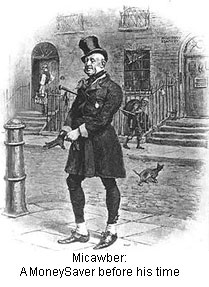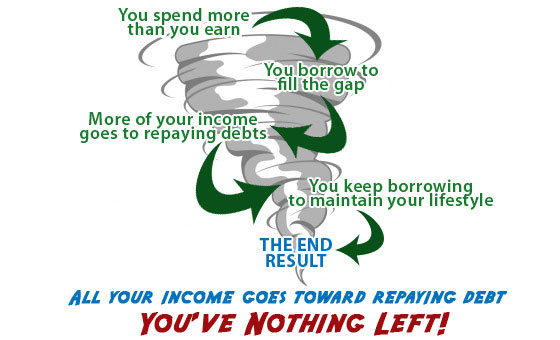The problem with most budgets is they don't work! They look at a typical month's spending, yet we don't spend by the month - what about the daily coffee, weekly shop, annual holiday?
This unique budgeting guide counters that, and includes sophisticated free budget planner tools, which analyse your finances and then help you manage and control your cash.
In this guide
| Tweet | http://bit.ly/uChAC |
What's the point of a budget?
 A budget done correctly is the most precise tool for analysing your finances imaginable. It answers two key questions...
A budget done correctly is the most precise tool for analysing your finances imaginable. It answers two key questions...
-
Do I spend more than I earn?
An instinctive assessment is easy - if you're eating up your savings or building up debts you're likely to be overspending. Yet before you can solve this it's important to get an accurate idea of the size and scale of the problem.
This is nothing new, after all Dickens' Mr Micawber laid out the principle pretty well in the 19th century:
"Annual income twenty pounds, annual expenditure nineteen six, result happiness
Annual income twenty pounds, annual expenditure twenty pounds six, result misery."
Major overspending can lead to a debt spiral and severe problems, that's why the Budget Planners are all designed to definitively answer this problem and give you a real assessment of your finances.
What can I afford to spend?
Once you know where you're spending, you can start to alter and prioritise what you do with your money to enable you to stick within your means.
While the budget planners include tools to enable you to work out how to prioritise within your means, the real difficulty is sticking to it; yet the Piggybank Technique is designed to do just that.
What's different about this budgeting technique?
It's oft said "In debt? Do a budget!", "Skint? Draw up a budget!", "Wife run off with the milkman? BUDGET!" Yet while budgetting is seen as a panacea, unfortunately most budgets are bunkum.
The main problem is that because they concentrate on a typical month, they massively underestimate your real spend, as this misses huge costs such as Christmas, summer holidays, new sofas or even changing car every five years.
Broad categories like "motoring" make it too easy to forget the small expenditures that add up. Instead it needs be MOTs, new tyres, petrol, insurance, breakdown cover and more, hopefully the budget planners counter that by having nearly 100 separate categories.

Watch The Video Guide
Courtesy of five tv.
Original transmission07/2008
Free Budget Planner: assess your finances
Please read the tips for filling it out below before starting the planners.
There are three versions of the free budget planner tool; the big online financial analyser tool, or if you prefer and have Excel or Open Office there's a spreadsheet version or even a good old fashioned print out.
Part of a couple/family?
It's very important to be consistent when budgeting. First decide who you're filling it out for: is it just for you or is it for your partner/family too? Finances often can't be separated in which case you should sit down and do it together.
Not sure of the exact figures
It's tempting to try and fool yourself by underestimating your expenditure. This is a MoneySaving sin, and you will be punished. Try and be accurate and, if you're not sure, guess larger not smaller - that way you'll have cash left over and not be short.
Plus don't double-count!
Some types of spending overlap into different groups; be careful not to count expenditure twice. For example if you've included your car insurance in the motoring section, don't include it again under insurance.
Pay special attention to credit card repayments
The credit card section is designed for you to enter the cost of repaying your existing credit card debts. Don't confuse this with spending where you simply use your credit card and pay it off in full.
The best way to explain this is with an example. Say you spend £500 each month on food shopping that you pay for on your credit card but then pay off in full. This spending belongs in the food shopping column and not in the credit card column as, otherwise, you'll be counting it twice.
Don't include company pension contributions
Pension payments are included in the expenditure section; if you send a cheque or have a payment from your bank account each month to pay into your pension, include it there.
However, if your pension comes straight from your salary as a payroll payment, don't include it as, when you fill in the income section, you should just fill in the amount you receive after all deductions.
Treat holidays carefully
Remember that when you go on holiday, you'll have expenditure while you're away; but you also don't spend on the things you normally would. So you may want to reduce the amount you put in your holiday category by a little.
For example, say you normally spend £100 per week on food shopping and £30 on petrol. If you're abroad for the week, you won't spend this but you'll still be adding them in. Therefore if the holiday cost £700 and you spend £300 you may be tempted to put £1,000 in - but actually you're saving £130 of normal expenditure so it should only be £870.
MoneySave as you go!
It's always surprising to see quite how many different things you spend cash on. Worse still is how much money you truly spend on them. Yet there are always ways to save. It's worth considering that as you write them down - are you getting the best value for your money? Can you get them cheaper elsewhere? See the Money Makeover article for much more on this.
| Tweet | http://bit.ly/uChAC |
More Budget Planners
Doing the budget planner accurately should take about an hour; it's best if you gather together your bank and credit card statements first, preferably the last three months' worth. Between them it should list all standing orders, direct debits and give you an accurate idea of what you spend.
For example, for food shopping, gather together all your receipts for the last three months, add up all food spending listed, then divide by three to reach your average monthly spend.
If you can, also gather together your payslips to establish exactly what you earn plus any bills or other documents if possible (though your statements should also detail this info).
What the result really means...
Now we have a true picture of your income expenditure. Hopefully you've pressed the button at the end which tells you the real truth of your finances. Either you spend more than you earn or you earn more than you spend.

In the green?
Well done you!
Providing you've been honest with yourself, it's time to relax a little - but MoneySaving doesn't stop there. In fact it's just beginning. Paying less for things means you have more money in your pocket to enjoy life more (and possibly save some for the future too!)
The typical savings from doing this can be £3,000 - £5,000 a year. My estimate is it'll take a full day's work but look at the return. It'll be the best paid work you've ever done. The whole site is dedicated to doing this in every area of your lifestyle, but if you're looking for where to start, read the Money Makeover article.

In the red?
Don't run the risk of a debt spiral - sort it now!
Spending more than you earn may not seem like a big deal, yet it's a potential disaster - and not just financially. At best you'll be eating away at your savings; at worst, you'll need to borrow.
And this type of borrowing is the worst as it means you can't afford your lifestyle and thus there's no planning to the debt and no end in sight. Sadly I've seen this result in debt crisis too many times, and that doesn't just hit your pocket: it can hurt your home, family, mental health and relationship.
You may feel this is over-dramatising yet when there's no money left and you can't borrow more - and the creditors are asking for money back which you've no ability to repay - it touches every element of your life. This danger is what's called a 'debt spiral'. It works like this:

Many people fool themselves about this, a common thought is, "that doesn't happen to nice families like us". Well I'm afraid even if you're middle class, you're not insulated from debt, in fact you're in the prime category for debt crisis, it's crucial to take the blinkers off.
Far too many people in work with good salaries have bigger debts. If your non-mortgage debts exceed half your after-tax salary, it's a real issue
What to do if you've got an overspend...
There are a number of simple steps to go through to try and reduce it.
Step 1:
Pain-free savings - cut bills without cutting back
 This is about ensuring you live the same way but pay less to do so. It's pain-free as no lifestyle changes are needed.
This is about ensuring you live the same way but pay less to do so. It's pain-free as no lifestyle changes are needed.
Don't just look at the obvious credit cards, energy bills, mortgages, you can save on things like childcare, council tax and contact lenses too. To go through this in detail use the full step-by-step Money Makeover guide which shows you how to look at everything.
Step 2:
Reassess your finances incorporating the expected savings
Now, it's worth revisiting your budget planner, incorporating your new predicted expenditure based on the expected pain-free savings. What you do then depends on the result...
-
Now spending within your means? Congrats, no more change needed (unless you're saving up for something) but do keep monitoring your finances; effective budgeting is still worthwhile too see piggybanking.
Still spending more than you earn? Then it's time for step 3...
Step 3:
Cutting back - painful savings
 You need to spend less, do less and sell things until you are living within your means.
You need to spend less, do less and sell things until you are living within your means.
Start small.
Easy lifestyle changes make huge differences, just check out TheDemotivator.co.uk to see the real impact of small spending. Cutting out a daily £2.50 coffee reduces your annual expenditure by £625/year. Add magazines, cigarettes, chocolate, parking and more, and savings mount rapidly.Run through what don't you need.
Ask yourself two questions for every aspect of your life...Do I need it?
If I do, could I still satisfy the need to an extent more cheaply?This may mean having the self-discipline to cut out cinema trips and expensive Christmas's or half-compromises like switching Sky for Freeview or stopping costly holidays abroad in favour of holidaying at home.
See the stop spending guide for full help.
Don't be afraid to sell things.
If you have assets but are income poor, then consider flogging things you don't use or need to get the books to balance. Though of course it's a one off, but hopefully you can use the money to repay debts or get your savings back together.
This may be be things like a car or motorbike, working through your wardrobe and selling old clothes (see the eBay sellers guide), or single things like selling old mobiles (use mobilevaluer.com to get the best price). If you've got it and won't use it, consider flogging it.
Are your debts severe?
Yet if things are so grave even this doesn't touch the side, it's likely you're in serious debt and need urgent guidance. Visit free non-profit debt crisis agencies like Citizens Advice Bureau, Consumer Credit Counselling Service or National Debtline as soon as possible.
Piggybanking: Ensure you have the money
Now we know what you currently spend money on it's time to rework it so that you're spending the appropriate amount; enabling you to keep control of your cash flow and balance the books.
There are two key facts you need to understand before you start to budget properly.

You can't trust your bank account.
Your bank account lies. When you check it, it only shows you a simple snap shot of the scene that day. It misses out what payments are due in or out, when direct debits are paid, when you need to do a shop. Never think that having cash in your bank account means your budget is balanced, though being overdrawn is a good indicator it isn't.
Don't ask "What's the cheapest way?" Ask "What can I afford?"
To get back on track, the most important thing to do is to understand that your finances must lead your lifestyle, not vice-versa. Many people look for the cheapest way to do something and consider that to be MoneySaving, yet actually if you're overspending it's more important to allow what you do to be driven by how much money you have, not by what you want to do.
Let me clarify this with an example. People often get themselves into trouble at Christmas time by asking "how do I have a great Christmas, with a big tree, all the family round for dinner and hi-tech prezzies for all the kids on the cheap?"
This is a bad question; it establishes your priorities without reference to how much money you've got. The right question to ask is 'What can I afford to spend this Christmas?' and plan your activities around that.
The Piggybank Technique
Now you know what money you have, you need to ensure you stick to it. This requires discipline, but it's much easier to do if you organise yourself effectively. To help with this I developed a simple system, called 'piggybanking', which has two simple steps to it.
Step 1:
Use the Budget Planner to work out what money you have.
You may've been wondering until now what the "Part C - Monthly desired spend" column of the Budget Planner is for. The idea is once you've done all the savings in the Money Makeover article you can now prioritise your finances to balance your budget. Simply allocate the spending as necessary to match up what you plan to spend with the amount of money you have coming in.
Step 2.
Set up different bank accounts for different purposes
Now you know how much money you want to spend on different items, the aim is to make always knowing how much cash you have simple for you.
To do this, set up a number of different bank accounts, each with money in it for a different purpose, so the money's effectively in little pots. When you get paid or earn the cash, have direct debits or standing orders shift the cash over to them from your main bank account within a day or so of getting paid.
This is a bit like using a piggybank, putting money in different ones for different spending. Which accounts you choose depend on your own personal priorities and spending habits. Choose whatever suits your lifestyle and makes it easier for you.
A simple example of six accounts:
| Bills (including mortgage) |
| Family Food |
| Big purchases (sofa, car, kitchen) |
| Holidays |
| Christmas |
| Savings & Emergency Fund |
This means whatever is left in your main bank account is actually spendable each month. And you really know how much money you have to spend at Christmas or to go on your holiday - there's no fooling yourself anymore.
It's perfectly possible the end result of this is that you can't afford the holiday you wanted, but more importantly, it means follow it properly and you won't spend what you can't afford.
Spotted out of date info/broken links?
Email brokenlink@moneysavingexpert.com to let us know
Always double check the product details before signing up to them

LINKS THAT HELP THIS SITE (all have a * in above article)
(this has no impact on product or pick - see explanation below)
N/a
Explanation (of * links)
How this site is funded. Two types of contacts are listed. The first, which all have a * within the main body of the articles, help MoneySavingExpert.com stay free to use, as they're 'affiliated links' which invisibly take you usually via affiliate linkage or commercial money sites, which then pay this site. It's worth noting this means the third party used may be named on any credit agreements. The second type doesn't help and therefore doesn't have a *.You shouldn't notice any difference, the links don't impact the product at all and the editorial line (the things we write) is NEVER impacted by the revenue - we aim to look at all available products. If it isn't possible to get an affiliate link for the best product, it is still included in exactly the same way. For more details read how this site is financed.
LINKS THAT DON'T HELP THIS SITE
(please only use if necessary)
No * Link Available: Citizens Advice Bureau , Consumer Credit Counselling Service , National Debtline
Duplicate links of the * links above for the sake of transparency, but this version doesn't help MoneySavingExpert.com:
N/a


























